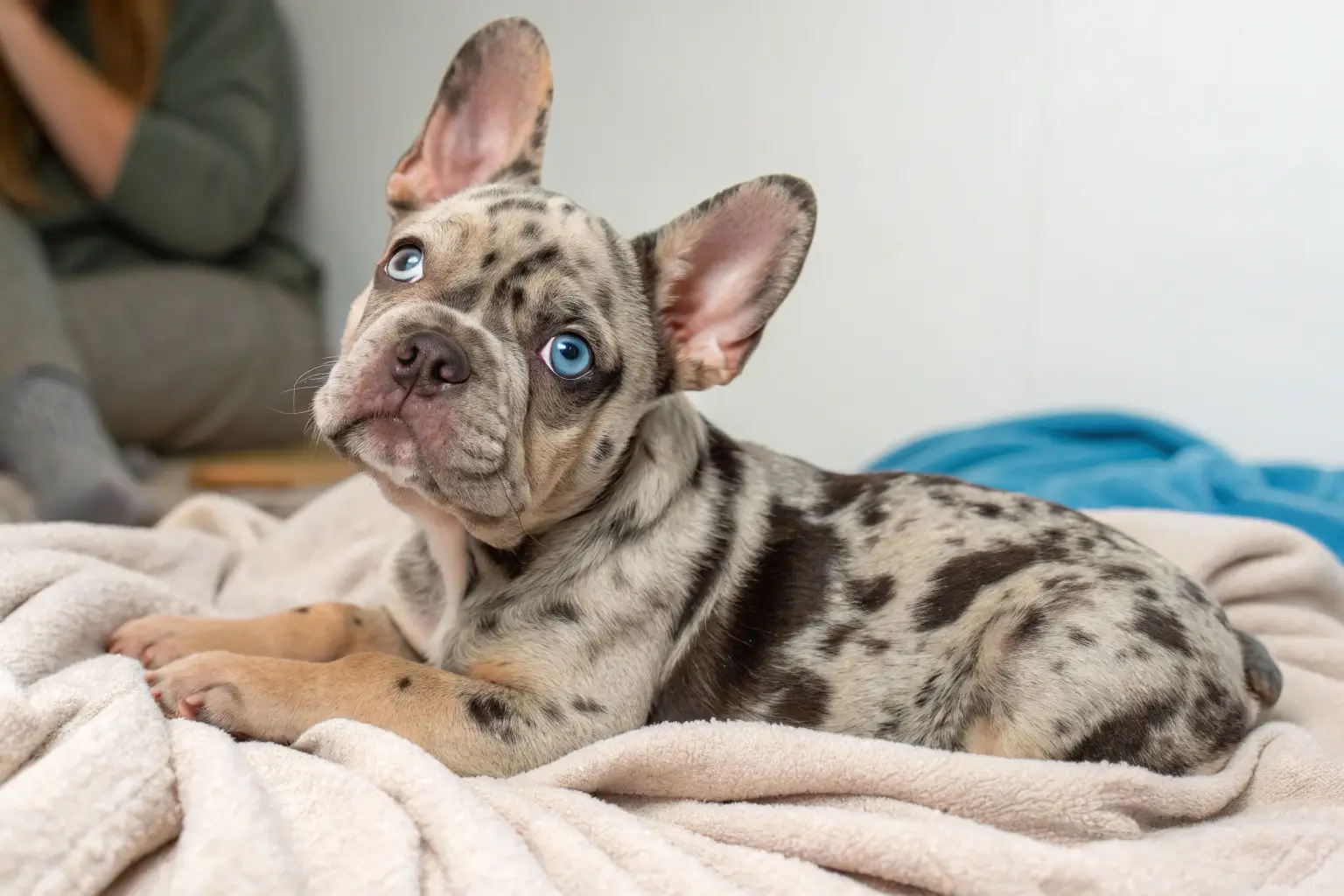Merle French Bulldog: 7 Fascinating Facts for Frenchie Lovers
Introduction
The merle French Bulldog, with its striking coat pattern of mottled patches and unique eye coloration, has captured the hearts of dog enthusiasts worldwide. This distinctive variation of the beloved French Bulldog has skyrocketed in popularity over recent years, becoming one of the most sought-after coat patterns in the Frenchie community. The merle French Bulldog isn’t just visually captivating—it represents a complex intersection of genetics, breeding practices, and canine health considerations that every prospective owner should understand.
Whether you’re a dedicated Frenchie enthusiast or considering bringing a merle French Bulldog into your family, understanding the nuances of this distinctive variation is essential for responsible ownership. The merle gene isn’t just about aesthetics; it carries implications for health, breeding ethics, and even registration status that can significantly impact your experience as a pet parent.
Did you know that no two merle French Bulldogs have the same exact pattern? Much like human fingerprints, each merle Frenchie sports a completely unique arrangement of patches and marbling, making your companion truly one-of-a-kind in the world of dogs. This remarkable genetic feature is just one of many fascinating aspects we’ll explore in this comprehensive guide to the merle French Bulldog.
Species Overview
Scientific Name: Canis lupus familiaris
The French Bulldog, including the merle variation, belongs to the domestic dog species. Despite their name suggesting French origin, Frenchies were actually developed in England in the 1800s before becoming popular in France. The merle pattern itself is the result of a specific genetic mutation within the breed.
Physical Characteristics
The merle French Bulldog displays the characteristic compact, muscular build of standard Frenchies, typically weighing between 16-28 pounds and standing about 11-12 inches tall at the shoulder. What sets them apart is their distinctive coat pattern characterized by diluted patches of color upon a lighter background, often creating a mottled or dappled appearance.
Merle Frenchies can display this pattern in vahttps://www.animalfriendfacts.com/wp-content/uploads/2024/06/woman-traveling-in-france-2023-11-27-05-16-47-utc_Easy-Resize.com_.jpgus color combinations, including blue merle (a diluted black base with gray patches), chocolate merle (brown patches), and lilac merle (a diluted liver color). One of their most striking features is heterochromia—different colored eyes or partially colored eyes—which frequently accompanies the merle gene. Their signature bat-shaped ears, flat faces, and stocky bodies remain consistent with the standard French Bulldog appearance.
Subspecies and Variations
While not technically subspecies, the merle French Bulldog comes in several recognized variations:
Blue Merle: The most common variation, featuring a diluted black base coat with patches of gray, black, and sometimes tan points.
Chocolate Merle: Displays a brown base with lighter brown mottling.
Lilac Merle: A rare variation with a diluted chocolate base creating a pale, grayish-purple appearance.
Double Merle: Results from breeding two merle dogs together, creating a predominantly white dog with minimal merle patterning. This variation is associated with significant health concerns.
It’s important to note that the merle pattern is not naturally occurring in French Bulldogs’ original genetic makeup. The merle gene was introduced through crossbreeding with other merle-carrying breeds, which has generated significant controversy within breeding circles regarding breed purity and health implications.
Habitat and Distribution
Natural Habitat
As a domesticated companion breed, the merle French Bulldog’s natural habitat is alongside their human families. These dogs are primarily indoor pets that thrive in temperature-controlled environments. Due to their brachycephalic (flat-faced) structure, Frenchies, including merle variations, are particularly sensitive to extreme temperatures—especially heat, which can lead to respiratory distress and overheating.
The ideal living conditions for a merle French Bulldog include a comfortable home with moderate temperatures, access to soft resting areas, and limited exposure to stairs or jumping requirements due to their susceptibility to spinal issues.
Geographic Range
Merle French Bulldogs can be found worldwide but are particularly popular in the United States, United Kingdom, Australia, and Canada. Their prevalence has increased significantly in the last decade as the pattern has become more desirable among pet owners.
In terms of registration and recognition, it’s worth noting that the merle coloration is not accepted by all major kennel clubs for French Bulldogs. The American Kennel Club (AKC), for instance, does not recognize the merle pattern as standard for the breed, which has implications for registration and showing.
Adaptations
The merle French Bulldog retains the same physical adaptations as standard French Bulldogs, which have evolved primarily as companion animals. These include:
- A compact, muscular build that doesn’t require extensive exercise
- A friendly, sociable temperament suited for family living
- Minimal shedding coat that adapts well to indoor environments
However, it’s crucial to understand that many of the French Bulldog’s physical characteristics—including their flat faces, compact airways, and susceptibility to overheating—are actually human-created features rather than natural adaptations. These physical traits can present health challenges that require special care and consideration from owners.
The merle pattern itself offers no survival advantages and is purely an aesthetic feature selected by breeders for its visual appeal. In fact, the genetics behind the merle pattern can sometimes be associated with sensory impairments, particularly when two merle dogs are bred together, resulting in what’s known as “double merle.”
Diet and Feeding Habits
What It Eats
The merle French Bulldog has the same dietary requirements as standard French Bulldogs. As domesticated pets, they thrive on high-quality commercial dog foods specifically formulated for small to medium brachycephalic breeds. A balanced diet for a merle Frenchie typically consists of:
- High-quality protein sources (chicken, beef, fish)
- Complex carbohydrates for energy
- Fruits and vegetables for essential vitamins and minerals
- Healthy fats for coat health and cellular function
Due to their propensity for weight gain and potential for food allergies, many merle French Bulldog owners opt for specialized diets. Some veterinarians recommend grain-free options, though this should be discussed with your pet’s healthcare provider, as recent research has raised questions about grain-free diets and heart health in dogs.
Hunting or Foraging Behavior
Unlike their distant wolf ancestors, French Bulldogs including merle variations have no natural hunting or foraging instincts that impact their daily lives. These dogs have been selectively bred over generations to be companion animals rather than working or hunting dogs.
Their feeding behavior typically involves scheduled mealtimes provided by their owners. They do retain some natural canine behaviors like food guarding or enthusiastic eating, but these are vestigial behaviors rather than necessary survival skills.
Dietary Needs
Merle French Bulldogs have specific dietary considerations that owners should be aware of:
Calorie Control: Their relatively low exercise requirements and tendency toward obesity mean caloric intake must be carefully monitored. Most adult Frenchies need approximately 25-30 calories per pound of body weight daily.
Feeding Schedule: Most veterinarians recommend feeding adult Frenchies twice daily to help prevent gastric issues and maintain stable blood sugar levels.
Hydration: Proper hydration is crucial, particularly given their susceptibility to overheating. Fresh water should always be available.
Allergies: French Bulldogs, including merles, can be prone to food sensitivities. Common allergens include beef, dairy, wheat, chicken, and soy. Some owners find that limited-ingredient or hypoallergenic diets help manage symptoms like itchy skin, ear infections, or digestive issues.
It’s worth noting that no special dietary requirements are linked specifically to the merle pattern itself. The nutritional needs of a merle French Bulldog are determined by their size, age, activity level, and individual health conditions rather than their coat color genetics.
Behavior and Social Structure
Social Behavior
Merle French Bulldogs exhibit the characteristic sociable, affectionate temperament that has made Frenchies one of the most popular companion breeds worldwide. These dogs are typically:
- Highly people-oriented, forming strong bonds with their owners
- Playful and moderately energetic, enjoying short play sessions
- Good with children when properly socialized
- Generally accepting of other pets, especially when introduced young
Their compact size and generally adaptable nature make them well-suited for vahttps://www.animalfriendfacts.com/wp-content/uploads/2024/06/woman-traveling-in-france-2023-11-27-05-16-47-utc_Easy-Resize.com_.jpgus living situations, from apartments to homes with yards. However, their strong attachment to their human families can sometimes translate into separation anxiety if left alone for extended pehttps://www.animalfriendfacts.com/wp-content/uploads/2024/06/woman-traveling-in-france-2023-11-27-05-16-47-utc_Easy-Resize.com_.jpgds.
It’s important to note that the merle coloration has no scientific correlation with behavioral differences. While some owners anecdotally report personality differences between merle and standard French Bulldogs, these observations aren’t supported by research and likely reflect individual temperament variations rather than color-linked behavioral traits.
Communication
Merle French Bulldogs communicate through a combination of vocalizations, body language, and facial expressions:
Vocalizations: While not extremely vocal compared to some breeds, Frenchies do “talk” through an array of grunts, snorts, and snuffles. They typically bark only when they feel it’s necessary, such as alerting to strangers or expressing excitement.
Body Language: Tail wagging, play bows, and relaxed postures indicate happiness and comfort, while raised hackles or stiff body postures may signal anxiety or alertness.
Facial Expressions: Their expressive faces, with prominent eyes and mobile ears, clearly communicate emotions from joy to concern.
One communication challenge specific to some merle French Bulldogs is potential hearing impairment, as the merle gene can be associated with congenital deafness, particularly in double merles. Owners of hearing-impaired Frenchies often develop hand signals and visual cues to communicate effectively.
Mating and Reproduction
Reproduction in merle French Bulldogs requires special consideration due to both the general reproductive challenges faced by all French Bulldogs and the specific genetic implications of the merle pattern:
Breeding Challenges: French Bulldogs typically require artificial insemination and cesarean sections for successful reproduction due to their narrow hips and the puppies’ relatively large heads.
Merle Genetics: The merle gene (M) is dominant, meaning a dog needs only one copy to display the merle pattern. When two merle dogs are bred together, approximately 25% of puppies may inherit two copies of the merle gene (MM), becoming “double merles.”
Double Merle Risks: Double merle puppies face significantly higher risks of severe health problems, including deafness, blindness, and other developmental issues. For this reason, responsible breeders never mate two merle dogs together.
Litter Size: French Bulldog litters typically range from 2-4 puppies, with gestation lasting approximately 63 days.
Developmental Timeline: Puppies open their eyes around 10-14 days, begin weaning at 3-4 weeks, and typically remain with their mother until at least 8-10 weeks of age.
Ethical breeding practices are particularly important with merle French Bulldogs. Reputable breeders phttps://www.animalfriendfacts.com/wp-content/uploads/2024/06/woman-traveling-in-france-2023-11-27-05-16-47-utc_Easy-Resize.com_.jpgritize health testing, avoid double merle breedings, and breed for temperament and health rather than just rare colors or patterns.
Conservation Status

Endangerment Level
As a domestic dog breed variation, the merle French Bulldog has no conservation status with wildlife organizations like the IUCN Red List. In fact, merle French Bulldogs have seen a dramatic increase in popularity and numbers over the past decade, driven by their unique appearance and rising demand for unusual coat patterns.
However, there are legitimate concerns within the dog breeding community about genetic health and breed standard integrity. Several major kennel clubs, including the AKC, do not recognize the merle pattern as standard for French Bulldogs because the gene is considered to have been introduced through crossbreeding with other breeds rather than occurring naturally within the French Bulldog lineage.
Threats
While not threatened with extinction, merle French Bulldogs face several challenges:
Genetic Health Issues: The merle gene itself is associated with an increased risk of auditory and visual impairments, particularly in double merles.
Over-breeding: The high demand for merle Frenchies has led to irresponsible breeding practices, with some unethical breeders phttps://www.animalfriendfacts.com/wp-content/uploads/2024/06/woman-traveling-in-france-2023-11-27-05-16-47-utc_Easy-Resize.com_.jpgritizing color over health and temperament.
Inflated Prices: Their popularity has driven prices to extreme levels (often $5,000-$10,000 or more), encouraging puppy mills and irresponsible breeding operations.
Registration Limitations: Some kennel clubs refuse to register merle French Bulldogs, believing the coloration indicates crossbreeding that compromises breed purity.
Conservation Efforts
Rather than traditional wildlife conservation, efforts regarding merle French Bulldogs focus on ethical breeding practices and education:
Breed Organizations: Some French Bulldog clubs have developed educational programs about the risks of merle-to-merle breeding and the importance of health testing.
Genetic Testing: Advances in canine genetic testing now allow breeders to identify carriers of the merle gene, even those with cryptic merle patterns that aren’t visibly apparent.
Rescue Organizations: Specialized French Bulldog rescue groups work to rehome Frenchies, including merles, that have been abandoned or surrendered due to health or behavioral issues.
Owner Education: Veterinarians and responsible breeders are increasingly working to educate potential owners about the health considerations specific to both French Bulldogs generally and merle patterning specifically.
The focus of these efforts is not on increasing numbers but on improving the genetic health and welfare of existing and future merle French Bulldogs.
Interesting Facts
Genetic Marvel: The merle pattern in French Bulldogs results from a dominant gene that affects the distribution and intensity of pigment, creating the characteristic mottled appearance. This same gene can influence eye color, often resulting in striking blue eyes or heterochromia (different colored eyes).
Hidden Merles: Some French Bulldogs carry what’s called “cryptic merle” or “phantom merle,” where the gene is present but minimally expressed in the coat pattern. These dogs can still pass the merle gene to offspring, sometimes surprising breeders with merle puppies from seemingly non-merle parents.
Pattern Uniqueness: Like human fingerprints, no two merle patterns are exactly alike. Each merle French Bulldog has a completely unique arrangement of patches and marbling.
Celebrity Status: Merle French Bulldogs have gained significant popularity among celebrities, further driving their desirability. Lady Gaga, Dwayne “The Rock” Johnson, and many social media influencers have showcased their merle Frenchies to millions of followers.
Controversial Origins: The presence of the merle gene in French Bulldogs is controversial because many breed experts believe it could only have entered the breed’s gene pool through crossbreeding with other merle-carrying breeds like Chihuahuas or Australian Shepherds.
Value Variation: The price difference between standard French Bulldogs and merle variations can be substantial. While a standard Frenchie from a reputable breeder might cost $1,500-$3,000, merle French Bulldogs often command prices of $5,000-$15,000 or more.
Pattern Development: Merle puppies are often born with less distinct patterns that develop and become more pronounced as they mature. The pattern can continue to change slightly throughout the first year of life.
Tips for Caring for the Animal
Proper Care and Feeding
Temperature Management: Due to their brachycephalic (flat-faced) structure, merle French Bulldogs—like all Frenchies—are extremely sensitive to heat. Keep your home cool, avoid exercise during hot weather, and never leave your Frenchie in a car or outdoors in warm conditions.
Dietary Considerations: Feed high-quality dog food appropriate for small-to-medium brachycephalic breeds. Divide daily food into at least two meals to aid digestion, and use portion control to prevent obesity, which can exacerbate breathing issues.
Exercise Balance: While not high-energy dogs, merle French Bulldogs do need regular, moderate exercise—typically 20-30 minute walks daily, split into shorter sessions in warm weather. Avoid strenuous activity that could stress their respiratory system.
Grooming Needs: Their short coats require minimal grooming—weekly brushing is usually sufficient. However, pay special attention to facial wrinkles, which should be cleaned regularly to prevent infection, and keep ears clean and dry.
Training Approach: Merle French Bulldogs respond best to positive reinforcement training methods. They can be somewhat stubborn but are intelligent and eager to please. Early socialization is essential for developing a well-adjusted adult dog.
Health Considerations
Merle French Bulldogs are susceptible to all the health concerns common to standard French Bulldogs, plus some additional considerations related to the merle gene:
Respiratory Issues: All French Bulldogs are prone to Brachycephalic Obstructive Airway Syndrome (BOAS), which can cause breathing difficulties, especially during exercise or in hot weather.
Sensory Impairments: Merle French Bulldogs have a higher risk of hearing and vision problems, particularly if breeding practices were not carefully managed. Consider having your merle Frenchie tested for hearing impairment, especially if you notice any signs of reduced auditory response.
Spinal Problems: Intervertebral Disc Disease (IVDD) is common in French Bulldogs. Limit jumping, use harnesses instead of collars, and consider ramps for accessing furniture or cars.
Skin Issues: Their skin folds require regular cleaning and inspection for signs of irritation or infection. Some merle French Bulldogs may have more sensitive skin requiring special shampoos or treatments.
Regular Veterinary Care: Annual check-ups are essential, with particular attention to respiratory function, hearing, and vision. Many veterinarians recommend baseline testing for young adult French Bulldogs to detect any early signs of breed-specific issues.
Dental Health: Small breed dogs, including French Bulldogs, are prone to dental problems. Establish a routine of regular teeth brushing and provide appropriate dental chews.
Genetic Health Testing: If considering breeding, comprehensive genetic health testing is absolutely essential to reduce the risk of passing on inherited conditions.
Role in the Ecosystem
Ecological Importance
As domesticated companion animals, merle French Bulldogs don’t play a role in natural ecosystems in the way wild species do. Their primary “ecosystem” is the human household, where they fulfill important social and emotional roles for their owners.
Within the domestic sphere, French Bulldogs serve as:
- Companions providing emotional support and companionship
- Family members enhancing social connections
- In some cases, therapy or emotional support animals helping people with vahttps://www.animalfriendfacts.com/
From a broader perspective, purebred dogs like French Bulldogs represent centuries of selective breeding that has developed specific traits for human companionship. The merle pattern specifically represents a more recent aesthetic preference that has gained popularity within the last few decades.
Impact of Decline
While not at risk of extinction, any hypothetical decline in merle French Bulldogs would primarily impact:
Breeding Communities: Breeders who have specialized in producing merle Frenchies would need to redirect their programs.
Owner Communities: The passionate community of merle French Bulldog owners and enthusiasts would diminish.
From a genetic diversity standpoint, the loss of the merle gene in French Bulldogs would actually represent a return to the breed’s traditional genetics, as many breed purists argue that the merle coloration was not originally part of the French Bulldog’s genetic makeup.
It’s worth noting that debates exist within the dog community about whether merle French Bulldogs should be continued as a variation at all, given the health concerns associated with the merle gene and questions about how it was introduced to the breed. This differs significantly from conservation concerns for wild species, where genetic diversity is typically beneficial for population resilience.
Conclusion
The merle French Bulldog represents a fascinating intersection of canine genetics, breeding practices, and the evolving relationship between humans and companion animals. Their distinctive, one-of-a-kind coat patterns have captivated dog lovers worldwide, making them one of the most sought-after variations of this already popular breed.
Throughout this exploration, we’ve discovered that merle Frenchies share the lovable, affectionate temperament of all French Bulldogs while displaying unique aesthetic qualities that set them apart. We’ve also examined important considerations regarding their health, care requirements, and the ethical questions surrounding their breeding.
For prospective owners, the decision to bring a merle French Bulldog into your family should be made with careful consideration of both the joys and responsibilities involved. These charming companions offer unwavering loyalty and distinctive beauty but require informed care to address their specific health needs. When acquired from responsible breeders who phttps://www.animalfriendfacts.com/wp-content/uploads/2024/06/woman-traveling-in-france-2023-11-27-05-16-47-utc_Easy-Resize.com_.jpgritize health over mere appearance, merle French Bulldogs can be wonderful, healthy companions.
If you’re considering a merle French Bulldog, we encourage you to research breeders thoroughly, ask about genetic testing, and consider the ethical implications of your purchase. Alternatively, rescue organizations occasionally have merle Frenchies available for adoption, offering a way to provide a loving home to a dog in need while enjoying the unique qualities of this remarkable variation.
Whatever path you choose, understanding the complete picture—from genetics to care requirements—will help ensure that the relationship between you and your merle French Bulldog is rewarding, ethical, and built to last.
Frequently Asked Questions
Are merle French Bulldogs recognized by major kennel clubs?
Most major kennel clubs, including the American Kennel Club (AKC), do not recognize the merle pattern as a standard color for French Bulldogs. This is primarily because the merle gene is believed to have been introduced through crossbreeding with other breeds, rather than occurring naturally in the French Bulldog lineage. However, some merle French Bulldogs may still be registered if their parents were registered, though they would not be able to compete in conformation shows.
Why are merle French Bulldogs so expensive?
Merle French Bulldogs typically command premium prices due to several factors: their relative rarity, high demand for their unique appearance, the general expenses associated with ethical French Bulldog breeding (including artificial insemination and c-sections), and additional health testing specific to merle genetics. Prices commonly range from $5,000 to $15,000 or more, though it’s important to note that a higher price doesn’t necessarily indicate a healthier dog or more responsible breeding practices.
What health issues are specific to merle French Bulldogs?
Beyond the health concerns common to all French Bulldogs (respiratory, spinal, and joint issues), merle French Bulldogs have an increased risk of auditory and visual impairments linked to the merle gene. These risks become significantly higher in “double merles” (dogs with two copies of the merle gene). Potential owners should seek breeders who conduct BAER hearing tests and eye examinations on their breeding dogs and puppies.
Is it true that breeding two merle dogs together is dangerous?
Yes. Breeding two merle-patterned dogs together creates approximately a 25% chance of producing “double merle” puppies (those inheriting the merle gene from both parents). Double merle puppies have a very high risk of sehttps://www.animalfriendfacts.com/wp-content/uploads/2024/06/woman-traveling-in-france-2023-11-27-05-16-47-utc_Easy-Resize.com_.jpgus health problems, particularly deafness and blindness, along with other developmental issues. Responsible breeders never mate two merle dogs together, regardless of the potential for more distinctively patterned puppies.
How can I verify if a French Bulldog is truly a merle and not a pattern-altered dog?
Unfortunately, some unethical individuals have been known to artificially create merle-like patterns through dyeing or other modifications to increase a dog’s selling price. The best verification comes through genetic testing, which can confirm the presence of the merle gene (M locus). Requesting documentation of the dog’s lineage and genetic testing from the breeder is the most reliable approach. Additionally, artificial patterns will grow out as the dog sheds and regrows its coat, while genuine merle patterns remain consistent (though they may change slightly as puppies mature).







